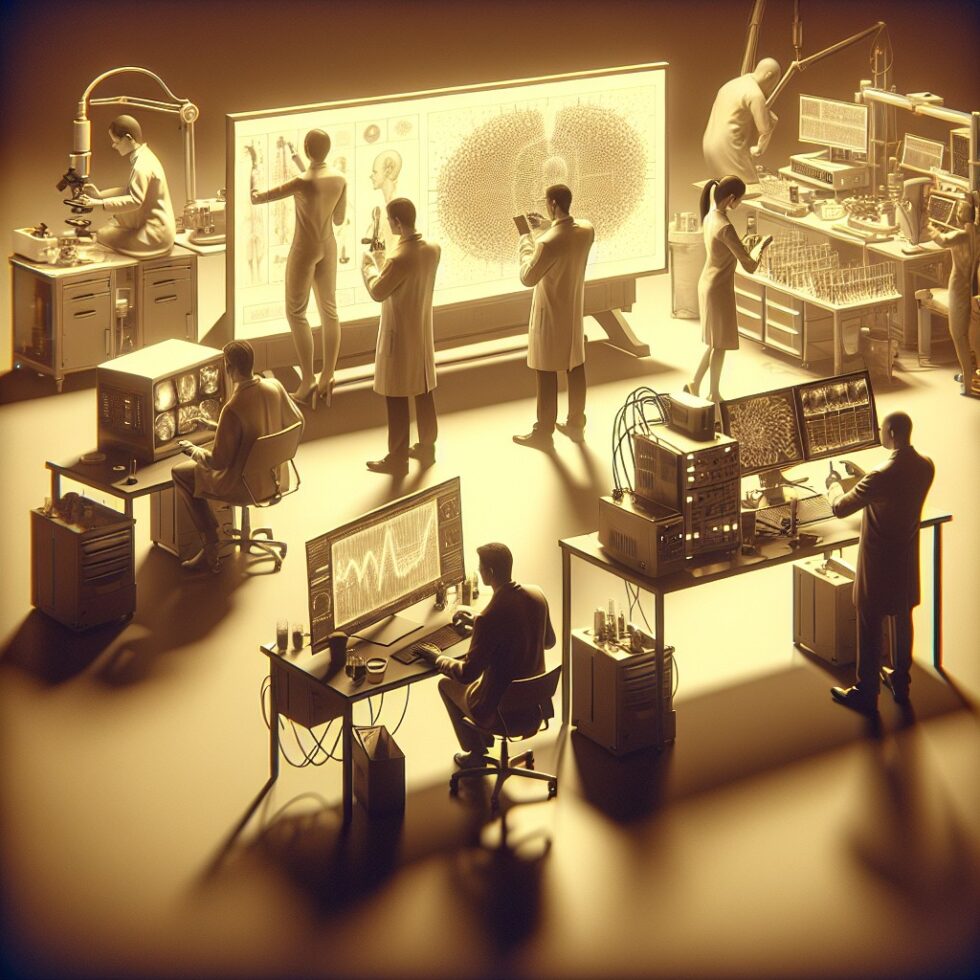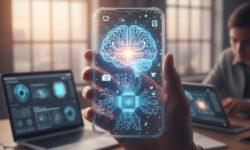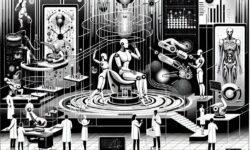
Artificial intelligence does not replace the scientific method; it adds new instruments to it. In the last few years, AI has moved from demos to daily tools across disciplines, from microscopes that see faint signals more clearly to detectors in physics labs that make faster decisions. This article is a straightforward guide to how AI actually shows up in scientific work, what changes inside the workflow, and how teams get value without turning research into a software project.
AI’s Sweet Spot in Science: Data With Structure and Questions With Constraints
Scientific data often looks different from internet data. It follows laws, has units, and arrives with uncertainties that matter. This structure is a gift to AI. Models can use it to learn more with less data and to avoid nonsense predictions.
Three patterns show up again and again where AI helps:
- Inverse problems: reconstructing causes from effects, such as turning a blurry image into a clearer one without adding false details.
- Signal detection: finding weak patterns buried in noise, like a tiny seismic phase inside a long waveform.
- Fast surrogates: building models that approximate slow simulations so you can explore more options in the same time.
What makes these useful is not only accuracy but also calibration. In science, being honest about uncertainty counts. Good tools return a value and a measure of trust, and they expose how that measure changes when the input changes. The best ones also bake in known physics or chemistry, so the model cannot violate conservation laws or create impossible molecules.
Sharper Sights: AI in Imaging, From Microscopes to Telescopes
AI now sits inside instruments. It does not just analyze images afterward; it can guide lenses, choose exposures, and decide what to record. This reduces wasted samples, time, and wear on equipment.
Cryo‑EM, microscopy, and seeing more with less dose
In cryo‑electron microscopy (cryo‑EM), deep networks automatically pick particle images in noisy micrographs, reducing hours of manual labeling. They also denoise and even suggest which regions of a sample are worth scanning next, decreasing electron dose on fragile specimens to preserve structure. In light microscopy, similar denoisers reduce phototoxicity by extracting usable signal from dim images.
Adaptive optics and reinforcement learning
In both biology and astronomy, adaptive optics use deformable mirrors to correct distortions. Traditionally, technicians tuned these systems by hand or with fixed algorithms. Now, reinforcement learning agents learn to nudge mirror actuators in real time, maximizing image sharpness even as conditions change. The result is more usable frames per session and better statistics for downstream measurements.
Tomography and inverse reconstruction
Tomography—reconstructing 3D objects from 2D projections—benefits from AI that solves the inverse problem under physical constraints. Learned priors keep reconstructions plausible and avoid hallucinations. When scientists add known symmetries or sparsity into the loss function, the model becomes both faster and more faithful to the physics of the instrument.
Practical check: avoiding “pretty but wrong”
One rule helps: never trust an AI reconstruction without a sanity check against raw measurements or a known standard. Good tools log which priors were used and how they affected the result. Visual beauty alone is not evidence.
Equations From Data: The Quiet Return of Symbolic Thinking
There is a strand of AI that does not just predict; it writes down candidate equations. Sparse discovery methods look for short, human‑readable formulas that explain a system’s behavior. These models are often easier to stress‑test than black boxes because you can inspect whether terms make sense.
Learning the form of laws
Sparse identification techniques search libraries of possible terms—polynomials, derivatives, products—and pick a minimal set that fits data. The payoff is insight: you not only predict trajectories but also learn which interactions matter. In fields where mechanisms are contested, a compact equation can reframe debate around a concrete hypothesis.
Physics‑informed neural networks
When equations are known but boundary conditions are messy, physics‑informed neural networks (PINNs) solve partial differential equations by optimizing a neural network that obeys the governing laws. This avoids meshing steps and can tackle complex domains. Scientists use PINNs for problems like flow in porous media or thermal profiles in irregular shapes. The catch is tuning. PINNs demand careful balancing of physics loss and data loss, and they benefit from domain knowledge about scales and units.
Uncertainty remains the currency
Both sparse discovery and PINNs should carry uncertainty estimates. Techniques such as ensembles and Bayesian layers can show when a model is extrapolating. Reporting this is part of scientific hygiene, just like reporting the number of replicates.
Fast Triggers and Clean Signals: AI in High‑Energy and Nuclear Physics
Particle physics experiments produce torrents of data. Only a tiny fraction is saved, and that choice is made at the front end by “triggers.” AI now runs inside these trigger systems to classify events in microseconds.
Inference on chips
Compact neural networks compiled for FPGAs run at detector edges. They distinguish interesting particle collisions from background and pass only promising snapshots to storage. This conserves bandwidth and lets researchers test richer theories without drowning in data. Models are pruned and quantized to meet power and latency budgets while preserving physics performance.
Differentiable detector design
Beyond analysis, scientists are building differentiable simulators where detector geometry and materials are parameters that gradients can flow through. This makes design itself an optimization problem. You can ask: which layout maximizes sensitivity to a rare event subject to cost and space constraints? AI does not choose in a vacuum; it gives engineers a map of trade‑offs that used to take months of simulation per option.
Earth Beneath, Water Around: AI in Geoscience and Ocean Work
Our planet is a stress test for pattern recognition. Signals are long, noisy, and full of confounders. AI helps by sifting, labeling, and flagging change for human review.
Seismology without waiting
Deep phase pickers label P and S wave arrivals in continuous data. This yields more consistent catalogs and speeds up aftershock analysis. In real time, models also estimate magnitudes and focal mechanisms with uncertainty bounds, giving early tools for hazard assessment without overpromising precision.
Landslides, floods, and melt
From satellite time series, models flag slope changes that precede landslides, surface water that signals flood extent, and ice front positions that mark glacier retreat. The win is not just detection but triage: scientists spend less time scanning images and more time investigating flagged regions. When models are trained per region with local labels, performance jumps—reminding teams that data specificity beats generic small boosts in model complexity.
Oceans: tracking invisible features
Ocean fronts and eddies shape ecosystems and transport heat. AI models trained on sea surface height and temperature fields spot these features and track them as they evolve. Fishermen and ecologists can then align surveys with dynamic features, improving sampling efficiency and reducing fuel use.
Field validation still rules
All remote sensing benefits from ground truth: a trip to the site or an in‑water probe. AI can suggest where to measure next, but in situ checks keep the loop honest.
Ancient Clues, New Tools: AI in Archaeology and Cultural Heritage
Archaeology blends sparse data with fragile evidence. AI assists by reading, grouping, and reconstructing patterns that would otherwise take years of manual effort.
Finding sites from the sky
With multispectral imagery and lidar, models highlight vegetation anomalies and micro‑topography that human eyes miss. Teams then overlay these maps with history and geology to prioritize surveys. This does not replace on‑foot excavation; it increases the chance that a dig uncovers something meaningful within limited time.
Reading fragmentary texts
Machine learning is helping specialists restore and classify inscriptions. Models trained on known scripts can suggest missing glyphs, align fragments, and map stylistic features to likely time periods. Crucially, tools are designed so epigraphers can accept, reject, or edit suggestions, and every action is logged for later review.
Preservation through segmentation
Three‑dimensional scans of artifacts are segmented into materials and layers with AI that learns from a few examples. Conservators then plan interventions with less risk to the original object because they know what lies under the surface.
Brains, Cells, and Signals: AI in Neuroscience and Biomed Research
In neuroscience, AI’s main job is to reduce bottlenecks in data processing so hypotheses can be tested faster.
Spike sorting and calcium traces
Electrophysiology recordings mix signals from many neurons. Deep models disentangle them, labeling spikes per neuron more consistently than manual clustering. In optical recordings, denoisers and deconvolution extract spike timings from calcium fluorescence traces, turning movies into time series suitable for analysis.
Connectomics and boundary detection
Electron microscopy volumes capture brain tissue at nanometer scales. Segmenting cells in this data is a monumental task. Networks trained to find boundaries and fill interiors now produce segmentations that support mapping of circuits. Quality control still requires human review, but AI cuts the workload to a manageable level.
From raw data to reproducible figures
In many labs, the most fragile part of the workflow is not the model; it’s the glue. AI now helps by parsing experiment logs, matching sample IDs, and catching unit mismatches. A consistent, machine‑readable trail from raw data to figure is a quiet win for reproducibility.
Data‑Centric Practice: What Successful AI Projects in Science Have in Common
Most scientific teams do not need the newest architecture. They need stable pipelines with good data curation and measured claims. Here is what works in practice:
- Start with a pin‑pointed question: “Reduce time to label seismic phases by 80%” beats “use AI in our lab.”
- Curate a small, high‑quality set: 500 well‑labeled examples often outperform 50,000 loose labels.
- Bake in physics and units: Normalize with meaningful scales. Penalize violations of conservation laws.
- Log decisions: Track which images were denoised, which priors were used, and who validated a result.
- Put uncertainty first: Return error bars along with predictions. Warn when inputs are out of distribution.
- Close the loop with users: Let experts correct the model in the interface and feed those corrections back.
- Deploy close to instruments: If a model guides acquisition, run it on the instrument PC or FPGA when possible.
- Measure cost and time: Report hours saved and samples preserved, not just accuracy and AUC.
Where AI Runs: From Laptops to FPGAs to the Field
Scientific AI does not live only in the cloud. It often runs where the action is.
On‑instrument inference
Microscopes and telescopes now ship with GPUs. Running models locally keeps latency low, helps with privacy, and reduces data movement. It also forces teams to keep models lean and maintainable—an underrated benefit.
Edge devices and FPGAs
Some detectors require microsecond decisions. That is where FPGAs and specialized accelerators come in. They execute simple networks at high speed and low power. It’s a different mindset: design for determinism, auditability, and tight resource budgets.
Cloud bursts for training
Training still often happens in the cloud, especially for 3D data. But upload only what you need. Pre‑compress, strip metadata that isn’t required for training, and cache intermediate tensors so you can resume without reprocessing everything.
Small Teams, Real Wins: Adopting AI Without a Big Budget
You can start with tools that are already good enough and free. The main investment is time to standardize data and set up validation.
A three‑week starter plan
- Week 1: Pick one narrow task (e.g., denoise low‑light microscope images). Gather 200 examples, define metrics that reflect scientific value (e.g., dose reduction, preserved features).
- Week 2: Try two open models. Keep a simple baseline (median filter, classical deconvolution) as a control. Record results and time saved.
- Week 3: Put the winner behind a button in your existing software. Add a feedback field for users to flag failures. Plan a re‑train schedule based on that feedback.
This approach is deliberately boring. It builds momentum and trust. Once one tool saves hours each week, it becomes easier to justify the next one.
What Changes for Scientific Culture
AI nudges teams to treat data as a first‑class product. That means:
- Shared dictionaries: Agree on names for samples, units, and conditions. Put them in a readme everyone can find.
- Versioned datasets: When labels change, tag a new version. Archive the old one. This mirrors code practices.
- Transparent models: Keep a model card that lists training data, known failure modes, and intended use. Simple text files are fine; clarity beats polish.
The gain is not only better AI; it’s a lab that is easier to onboard into and to audit years later.
Risks and How to Manage Them
Risks are manageable with simple habits.
Overfitting to lab quirks
Models may learn instrument‑specific artifacts instead of the signal. Rotate data across instruments and days. Hold out data from a different instrument as your final test.
Silent failure in the wild
When conditions change, models can drift. Build drift checks: simple statistics on inputs and outputs that trigger a warning or pause. Make it easy for users to report “this looks wrong” within the tool, not by email.
Opaque pipelines
Science depends on traceability. Every automated step should leave a breadcrumb trail: input file hashes, model version, parameters, and user who approved the result. This keeps results defendable during peer review.
Glimpses Ahead: Generative Tools That Respect Physics
Generative models are entering science, but the useful ones are tied to constraints. Imagine a tool that proposes new microscopy acquisition patterns, not random images; a model that suggests pulse sequences in NMR that maximize information given your sample; or a simulator that generates likely boundary conditions for climate sub‑models based on past cycles while conserving energy and mass.
The big shift will be AI that proposes experiments within safety and budget limits, and then updates suggestions as data arrives. This is not autonomy for its own sake. It is assistance that reacts to reality faster than a human can without sacrificing control or interpretability.
Case Notes Across Fields
Materials microstructure to property
Materials scientists link micrographs of grains and phases to mechanical properties. Models learn features that predict hardness or corrosion resistance. The twist is “domain randomization”: training on varied simulations and a small set of real images so the model generalizes to new alloys. As with all property predictions, the output includes confidence intervals; if uncertainty is high, that itself is a decision signal to run a physical test.
Gravitational wave glitches
Interferometers are sensitive to tiny disturbances like scattered light or ground noise. AI classifies glitch types so researchers can fix root causes. This is routine, unglamorous, and essential to improve time spent in science mode, when the instrument can detect true astrophysical events.
Environmental DNA and species detection
Water samples contain traces of DNA from organisms. AI helps match sequences to known taxa, flags possible novelties, and maps likely species presence by combining eDNA with local conditions like temperature and salinity. The key practice is cautious thresholds: report “possible presence” when evidence is thin and require additional confirmation before drawing ecological conclusions.
A Simple Checklist Before You Ship a Model to Your Labmates
- Is the metric meaningful? Prefer “time saved per dataset” or “radiation dose reduced” over generic accuracy.
- Did you test on a different day, instrument, or site? If not, you do not know if it generalizes.
- Can a user override it? A good tool supports expert judgment, not replaces it.
- Is there a log? If you cannot reconstruct how a figure was made six months from now, you will regret it.
- Who owns maintenance? Name a person, not a team. Models age; someone must watch them.
Why This Matters Now
Many fields are data‑rich but analysis‑poor. Instruments outpace the capacity of people to label, clean, and interpret what they collect. AI closes that gap. It shifts effort from drudgery to decisions and leaves a cleaner record behind. The end state is not a laboratory full of robots; it is a scientific workflow where computational help is part of the instrument, as ordinary as a lens or a pipette.
Summary:
- AI helps most in inverse problems, signal detection, and fast surrogates grounded in known physics.
- Imaging gains include denoising, adaptive optics control, and safer acquisition with lower doses.
- Equation‑aware methods like sparse discovery and PINNs add insight and flexibility when data and laws meet.
- High‑energy physics uses AI for fast triggers and even differentiable detector design.
- Geoscience and ocean work use AI for consistent labeling, change detection, and smarter field campaigns.
- Archaeology benefits from site discovery, text reconstruction, and 3D segmentation that aid conservation.
- Neuroscience reduces bottlenecks in spike sorting and connectomics while improving reproducibility.
- Data‑centric practice—curation, uncertainty, and logging—beats chasing the newest model for most teams.
- Deploy models close to instruments when possible; train in the cloud only as needed.
- Adopt with small, focused projects, clear metrics, and a plan for maintenance and drift checks.
External References:
- Bepler et al., Topaz: particle picking in cryo‑EM with positive‑unlabeled learning (Nature Methods)
- Raissi et al., Physics‑informed neural networks (Journal of Computational Physics)
- Lakshminarayanan et al., Simple and scalable predictive uncertainty with deep ensembles (arXiv)
- Gravity Spy: Citizen science and machine learning for gravitational wave detectors
- AlphaFold Protein Structure Database (EMBL‑EBI)
- Google Earth Engine: Planet‑scale geospatial analysis platform





